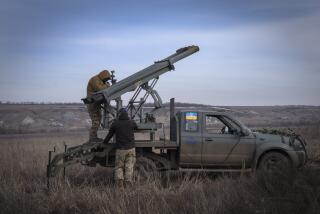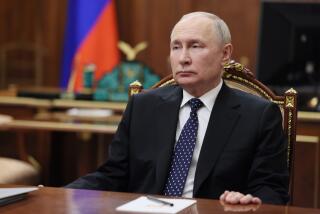22 Nations Sign Pact to Slash Europe Arsenals : Conventional arms: East-West ‘confrontation is over,’ U.S. aide says. Some verification problems persist.
- Share via
PARIS — President Bush, Soviet President Mikhail S. Gorbachev and the leaders of 20 other nations spanning Europe from East to West signed a historic agreement Monday to slash the vast arsenals of conventional weapons that threatened the Continent through four decades of Cold War.
Hailed by Bush as “the farthest-reaching arms agreement in history,” the pact provides for reducing the tanks, planes, artillery and other heavy armaments of the Soviet Union and its old Warsaw Pact allies by more than 50%. It will hold the conventional arms of the North Atlantic Treaty Organization close to present levels.
The treaty, known as the agreement on Conventional Forces in Europe, or CFE, marks “a grand turning point in the course of history,” Bush said.
While the abrupt disintegration of the Soviet Bloc had already made any near-term attack on Western Europe highly unlikely, the treaty is considered vital in assuring the long-term security of the NATO allies and, following their turn toward democracy, of East European nations as well.
Any future Soviet attempt to rebuild its present arsenals would take so long and be so conspicuous that the treaty “makes virtually impossible the kind of surprise attack that NATO has been worried about” since the dawning of the Cold War, Bush’s national security adviser, Brent Scowcroft, said.
“The confrontation is over,” he declared.
At the same time, however, Scowcroft acknowledged that “some problems” have arisen over the verification mechanisms contained in the CFE treaty.
By moving thousands of tanks and other weapons out of Europe and into depots east of the Ural Mountains, the Soviets have put them outside the scope of the treaty and effectively reduced the number of on-site compliance inspections that NATO will be able to conduct on Soviet soil.
U.S. officials had been aware of some Soviet moves and discounted them as a substantial threat. But the scale of the resulting reduction in sites qualifying for inspection took them by surprise.
An additional result of the Soviet move is that fewer Soviet weapons need to be destroyed under the treaty.
Scowcroft and other U.S. officials took a rather relaxed attitude toward these apparent discrepancies--between the Soviet figures presented last week and U.S. estimates of Soviet strength only last month--even though the issue could become a significant political problem for the Bush Administration when the treaty is submitted for ratification.
“The fact that all of the details still have not been completely agreed should not overshadow this historic treaty,” Scowcroft said.
Moscow will be challenged about all of the weapon totals submitted last week in Vienna, other U.S. officials said. But they pointed out that under the treaty, the Soviets can correct the figures during the next 90 days without penalty.
The treaty requires that NATO and the Warsaw Pact reduce their conventional armaments to equal ceilings on each side of 20,000 tanks, 20,000 artillery pieces, 30,000 armored combat vehicles, 6,800 aircraft and 2,000 helicopters.
Based on force levels in 1989, when the negotiations began, the Soviets would have had to make a 60% cut while NATO would reduce less than 5%.
But during the two years of talks, the Soviets moved huge amounts of weaponry beyond the Urals, to Siberia. Last month U.S. officials said that as a result of such transfers, only about half the armament once projected for destruction--50,000 items rather than 100,000--would have to be cut up or converted to peaceful uses.
Now it appears from information supplied by Moscow that even more weaponry has been moved.
This means that in addition to avoiding the mandatory destruction of those weapons, the Soviets will have to allow significantly fewer on-site inspections.
Several hundred such inspections each year had been anticipated, U.S. officials said. This was based on U.S. calculations that there would be more than 1,900 Soviet “objects of verification,” such as a regiment or a depot, open for scrutiny, and on the treaty’s provision that 10% of those “objects” were inspectable per year during the three-year period when arms reductions and destruction are to occur.
In fact, the Soviet data now submitted indicate that less than half the number of “objects” will exist and so less than half the expected inspections will be permitted, a U.S. official said.
“There are a number of problems, a number of things we don’t understand,” the official said in describing U.S. reaction to the Soviet weapon figures. “They have 90 days to correct them, update them. The biggest problem is probably the ‘objects of verification,’ but other aspects of the data don’t add up. We’ll be pursuing this matter with them.”
Another potential complaint is that because of the political upheavals in East Europe, Moscow’s former Warsaw Pact allies there can inspect Soviet territory under the treaty. Such inspections, by Romania, for example, apparently would reduce the number of inspections available to the United States and its NATO allies, according to a non-American source.
According to the U.S. chief negotiator on the treaty, Ambassador R. James Woolsey, the Soviets have promised that “most” of these weapons in Siberia, although beyond formal reach of the treaty, will be destroyed or converted to peaceful uses, such as turning a tank into a bulldozer.
Other officials have said Moscow also has promised at least a “partial” accounting of the weapons in Siberia. Officially, however, the Soviets could tell the United States that their disposition was none of its business and conceivably keep them mothballed for future use, perhaps by some successor regime less committed to improved East-West relations than the present one.
American satellites have found that many of the Soviet weapons are being left outside to rust in Siberia, and the Pentagon reportedly has expressed the opinion that the Soviets would require two years to reconstitute a force that could again threaten Western Europe.
But it is striking how, largely because of the new political rapport with Moscow resulting from Soviet reform efforts, these various assurances are being accepted by the Administration from the Soviet nuclear power that less than a decade ago was called the “evil empire.”
Woolsey flatly refused to discussed the issue. Only after analysis of the unprecedented volumes of weapon data is complete, he said, should there be discussion of the number of weapons to be destroyed.
WEAPONS CUTS IN EUROPE
The Conventional Forces in Europe (CFE) treaty signed Monday sets in motion the most sweeping arms reduction in history, with most cuts coming from Warsaw Pact arsenals.
Tanks
Limit: 20,000
What will be cut
NATO: 2,230*
E. Eur.: 5,050
Soviets: 11,748
What will remain
NATO: 20,000
E. Eur.: 6,850
Soviets: 13,150
Artillery
Limit: 20,000
What will be cut
E. Eur.: 6,875
Soviets: 5,125
What will remain
NATO: 18,500
E. Eur.: 6,825
Soviets: 13,175
Armored Combat Vehicles
Limit: 30,000
What will be cut
E. Eur.: 4,900
Soviets: 12,320
What will remain
NATO: 30,000
E. Eur.: 10,000
Soviets: 20,000
Aircraft
An additional 430 naval aircraft are permitted. Some trainer aircraft and planes on aircraft carriers are not limited.
Limit: 6,800
What will be cut
Soviets: 3,040
What will remain
NATO: 5,700
E. Eur.: 1,600
Soviets: 5,150
Helicopters
Treaty permits helicopters to be converted for support roles.
Limit: 2,000
What will be cut
NATO: 235
E. Eur.: 200
Soviets: 1,350
What will remain
NATO: 2,000
E. Eur.: 500
Soviets: 1,500
Figures are current estimates.
* Weapons of the former East Germany, in Germany at the time of the treaty signing, will count against NATO limits, but are excluded from totals.
Source: Arms Control Assn.
More to Read
Sign up for Essential California
The most important California stories and recommendations in your inbox every morning.
You may occasionally receive promotional content from the Los Angeles Times.










